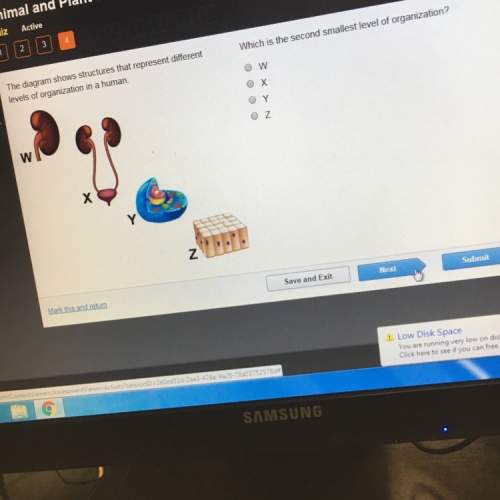
Biology, 12.04.2020 03:20 cakecake15
A person had an infection of his Peyer's patches and developed intestinal cancer. How could these two events be related?
Peyer's patches filter lymph in the intestine and would have removed the cancer cells.
Peyer's patches contain lymphocytes that may have killed the cancer cells.
Peyer's patches remove abnormal red blood cells, including cancer cells.
Peyer's patches secrete hormones that suppresses the reproduction of cancer cells.

Answers: 2
Another question on Biology

Biology, 21.06.2019 12:30
Apower plant recently purchased land and will be building a large factory on wetlands in florida. which of these is not an environmental effect of destroying these wetlands? question options: destroying the wetlands will create a loss of habitat for many species. destroying the wetlands will create flooding. destroying the wetlands will create species to relocate to a new area. destroying the wetlands will change the climate in this area.
Answers: 1

Biology, 21.06.2019 19:20
If vegetable oil is made out of veggies, then what is baby oil made out of?
Answers: 2

Biology, 22.06.2019 01:30
15 ! come and answer! a(n) disease is caused by a pathogen and can spread among organisms. a infectious b noninfectious c toxic d contaminated
Answers: 1

Biology, 22.06.2019 01:30
Scenario 5 1) take 10 red and 10 black beans and place them, mixed, on the table. record the starting phenotype # and frequencies (% of your total population) of your starting population in the table provided (generation 0). 2) act as a predator. “capture” as many organisms as you can until you have reduced the population to three organisms. put them aside. at this point, the predators die. 3) the remaining organisms each produce 2 clonal offspring. multiply your organisms accordingly and allow them to mix on the table. calculate and record the resultant phenotype # and frequencies (% of your total population) of your population in the table provided (generation 1). 4) repeat the reproduction event, allowing each of your organisms to produce 2 clonal offspring. calculate and record the resultant phenotype # and frequencies (% of your total population) of your population in the table provided (generation 2). 5) repeat the reproduction event, allowing each of your organisms to produce 2 clonal offspring. calculate and record the resultant phenotype # and frequencies (% of your total population) of your population in the table provided (generation 3).
Answers: 1
You know the right answer?
A person had an infection of his Peyer's patches and developed intestinal cancer. How could these tw...
Questions

Health, 26.01.2021 17:40

Chemistry, 26.01.2021 17:40

Mathematics, 26.01.2021 17:40


Mathematics, 26.01.2021 17:40

Chemistry, 26.01.2021 17:40

English, 26.01.2021 17:40

Mathematics, 26.01.2021 17:40

Mathematics, 26.01.2021 17:40


Social Studies, 26.01.2021 17:40




Mathematics, 26.01.2021 17:40





Social Studies, 26.01.2021 17:40




